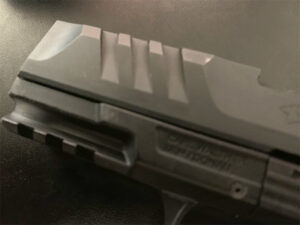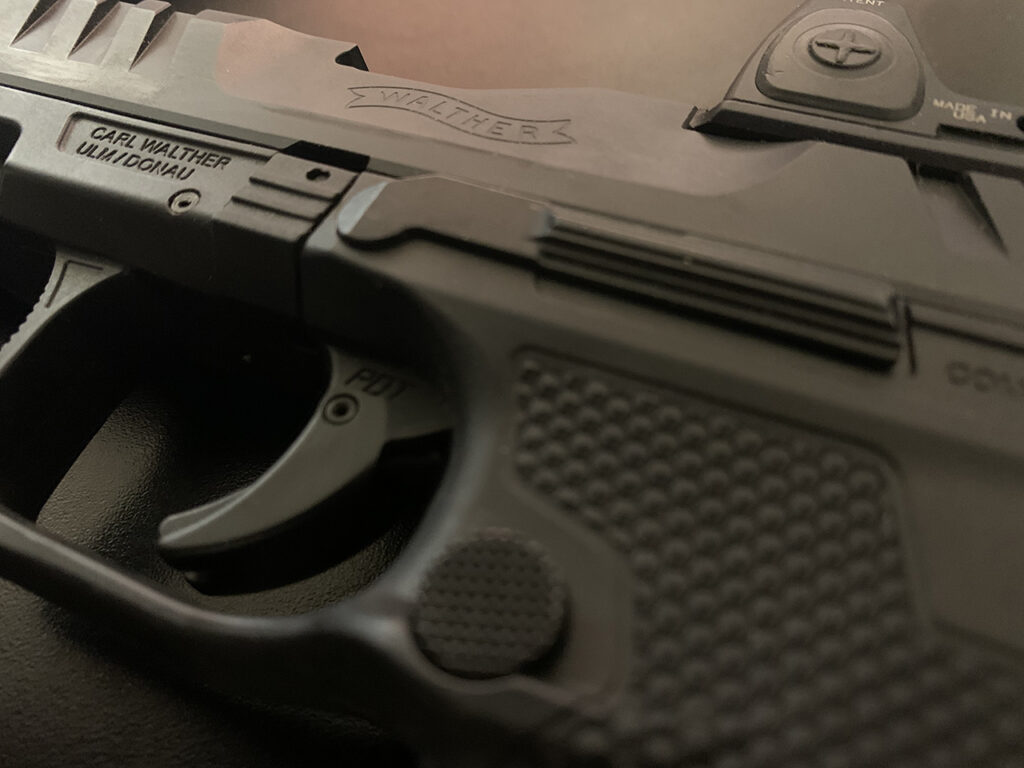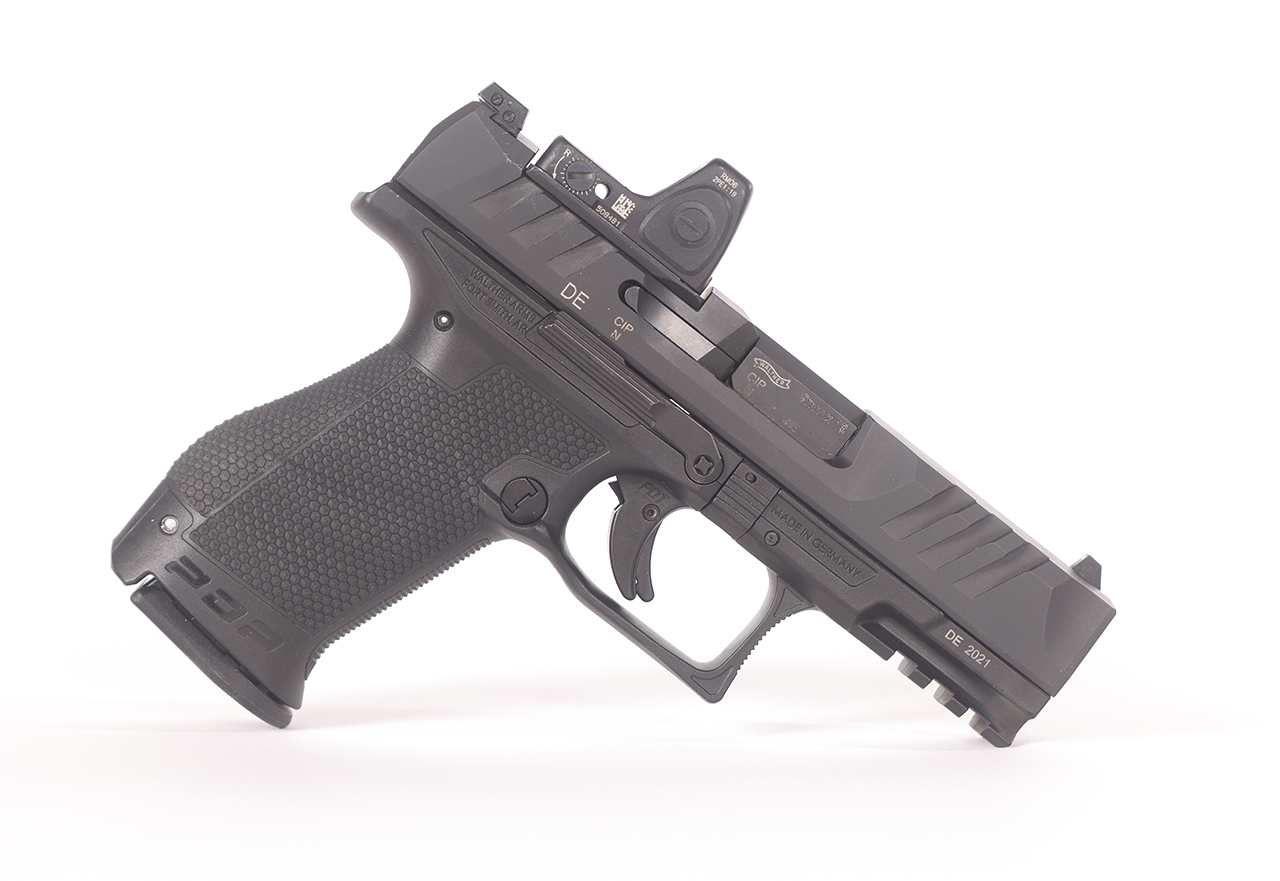Possibly the top shooting concealed handgun… if you can conceal it.
As a rule, I don’t like early-adopting a carry-intent handgun. I prefer to give it a year, let it hit the market, and with the public buying in mass, any issues will be seen. Simple statistics. The Walther PDP was designed and released in 2021, and has been on the market for just about a year. I bent my rule slightly for this because the reviews were largely great, but more importantly, reports of failures were nonexistent.
My recent evolution of carry handguns was the Heckler & Koch P30 (9mm), then the Glock 19 (9mm) with Trijicon RMR. I love the P30 for its ergonomics and accuracy. Its reliability is nearly legendary, and I have more rounds through it than any other handgun in my collection. It just fits right. When I got the Glock 19, it was primarily because most of my students have Glock 19’s so wanted to have plenty of trigger time on it to best help them. I opted for the MOS with the Trijicon RMR since this technology was entering the “widely proven reliable” status that is a proper benchmark for daily carry. I grew to love the red dot, and through regular practice was proficient at finding the dot.
When the Walther PDP came out, it became a way to “have it all”. Very high quality, well respected manufacturer, ergonomically superior firearm, ambidextrous equivalency, AND the MOS mounting built in. To top it off, grip texture that hit the sweet spot between grip stability and not too much roughness, and slide serrations that made grip exceptionally easy, without being “bitey”. Add to cart.

The shooting experience with the Walther PDP has been on par with my love of the H&K P30. In fact, because I have the RMR as a part of the system, it surpasses it.
That trigger tho…
The trigger is possibly the finest trigger on any production handgun. There is appropriate take up distance (the travel the trigger has between its fully forward resting position to when it begins to actuate the firing mechanism) for a defense-intent pistol.
This is followed up with a perfect transition to the trigger “wall” (where the trigger pull force becomes necessary to move the trigger back further). The trigger pull force is nearly perfect at 25 N (5.6 pounds), and the force profile from end of take-up to the wall is very quick, no feeling of starting to ‘overcome’ the wall (stacking or creep), just a clean, crisp break.
Overtravel (the distance the trigger can be pulled back after the break) is nearly nonexistant. Possibly 2mm of overtravel.
The trigger reset is defined, articulate, and consistent. The release distance to the reset is nearly perfect.
Ergo’s
Grip ergonomics are always a compromise between proper grip size and magazine space. The PDP grip is no exception, with a full, palm filling grip. Of course, there are three backstraps included in the box, accommodating multiple palm volumes. Walther even accommodated smaller grip shooters with an F-series of the same pistol featuring a much smaller grip circumference.

The slide serrations are “prominently discreet”. That seems like a complete contradiction until you’ve handled it, then it’s like “Yeah…”. They are very conspicuous and will likely become the hallmark feature of this pistol. (In fact, the plastic case this pistol comes in has design cues from these serrations.) When you cycle the slide for the first time, and your skin fills the serrations with positive purchase but the edges don’t bite, you’ll see. Walther found that perfect edge radius to negate any ‘sharp’ feeling, yet be angled enough to bite into anything available for a 1 hand slide-cycle or sticky hot mess slide manipulation on someone’s worst day ever.
The slide stop lever is ‘available’, but not the shelf-like lever that the P30 has. Nor does it need to be.

The grip texture is another home run. It is grippy without abrasion. Shots with wet hands were easily controlled.
I am in the minority with magazine releases. The P30 trigger guard ‘paddle release’ is a great feature, and I wish the PDP at least had it as an option. Nonetheless, it is well placed such that only purposeful pressing will be done.
Ultimately, it appears Walther looked at everything the Glock-modders do to turn their $500 gun into a $1500 gun while incurring $2000 in credit card debt. They then took those features and said “build these in to the production process”. The results are a $650 gun that is on par or better than the most respected names in production-volume firearms, such as H&K and Sig, with the feature-rich characteristics of a mod gun.
Concealability
For a “compact” class pistol, this gun is big. Those slide serrations come at the cost of extra mass to make that empty space. The gun’s width is 1.33″. To compare to a Glock 19 at 1.26 with a slide on only 1.0 inch thick, the Walther PDP is a bit bulky. Of course, it’s 2022 and even the ‘gold’ standard Glock 19 is getting dated as far as size goes. For instance, the Sig 365 boasts an overall thickness of only 1.0″. To complicate matters even more, “subcompact” class pistols are prominently 9mm and some have respectable magazine capacity.
For me at 6’2″ in height, I can manage to conceal the Walther PDP strong side, and also carry using a shoulder holster when I can. It is concealable, but I definitely know its there, and I’m sore some modest printing happens from time to time.
The great hubbub about the MOS mounting
Youtube is a great place for backwater “gun guys” to try to make a name for themselves, and the Walther PDP did not escape the musings of someone calling themselves a mechanical engineer. This particular hubbub centered on the MOS mounting strategy.
To mount an MOS red dot optic on a pistol, there is a milled out area atop the slide to lower the axis of the sight to the bore. The top of the slide in this area typically has some type of guide holes or grooves. The idea behind this is that when the slide cycles, the mechanical characteristics of the pins/grooves will absorb the forces generated from the slide cycling, so that the fasteners holding the optic on the slide don’t experience the force as much.

Next, an adaptor plate is used specifically made for that make/model gun. The bottom of the plate conforms to the hole/groove mounting strategy, usually having a couple pins, or a groove that mates with the slide’s grooves. The top of the mounting plate is specifically made for the optic desired. In a perfect world with no tolerances, the pins or grooves would indeed handle all the force generated as the slide cycles, leaving the fasteners with the only job of holding down the optic onto the slide.
The top of the slide on the first Walther PDPs was flat, with no mounting holes or grooves. A couple graduates of YouTube School of Engineering seized on this claiming the hardware WILL fail because the fasteners are doing all the work.
The issue with this claim is twofold: First, they don’t seem to take into account any form of tolerances. The reality is that even with the hole/pin method or ‘aligning groove’ method, there has to be some tolerances so that every adaptor plate will fit into every slide. The pins are necessarily smaller than the holes, and this extra space allows for minor movement of the plate relative to the slide. In short, the pins and grooves help, but they are not absolute insurance against “WILL fail”. As a corollary, the front/rear tolerance of the adaptor plate has similar tolerances, so any force generated will also prominently be mitigated on this characteristic.
Secondly, the YouTube Engineering Department failed to consider the metallurgical properties of the fasteners at all. There simply ARE metals that will handle the shear forces generated in this application. The metal against metal friction generated by the force these fasteners are tightened to, coupled with the shear resistance of proper hardware can, most assuredly, suggest that they will NOT fail. In fact, Walther tested their plates on multiple firearms to 60,000 rounds. In that test, ZERO issues were noted.
How it shoots
I’ll be doing a video on this so won’t get too detailed here. In short, it shoots like a dream. Recoil is well managed. Fast follow up shots are easy, and double taps (or controlled pairs or whatever the cool guys are calling it this week) had an average grouping of about 2.5″, commensurate with my H&K P30.
The ergonomic features make it a solid range gun. Target transition was fast, and the red dot did its job (fast target acquisition with defensive accuracy).
Conclusion
If you’re getting this gun for a CPL-intent role, be sure your method of carry, carry location, and clothing are all up to the task. It’s a bigger gun for a “compact” class. Nonetheless, magazine capacity is on point with other compacts, and it has the reliability and performance one expects from a Walther.

